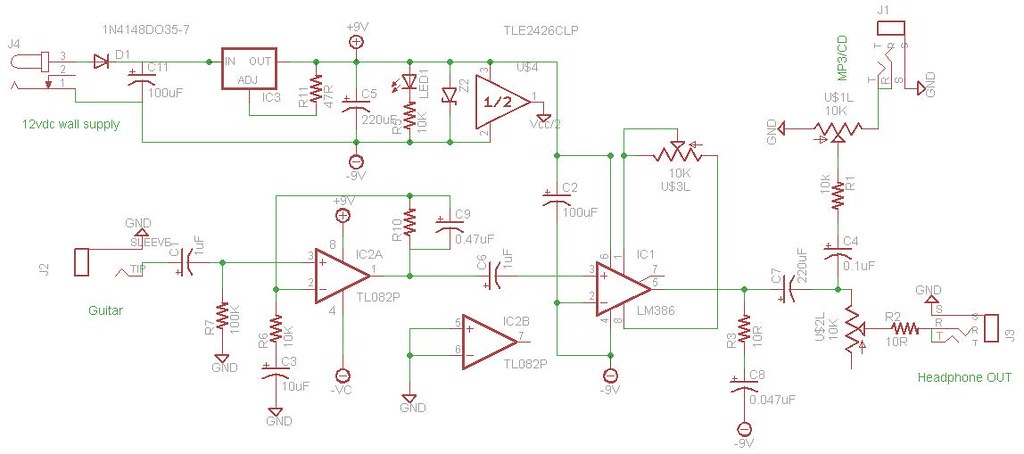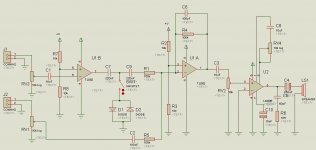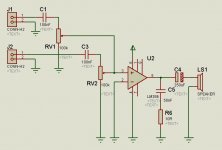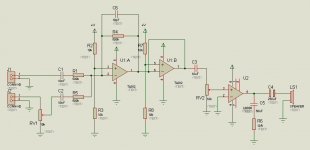Opps, I never finished the above post when I clicked submit and walked away;(
I should have said, I feel like the second is correct except for wakibaki's excellent explanation in post #16. Based on that, since the lm386 has a high natural input impedance, it sounds like I should have guitar into lm386, AUX into TL082P, sum both outputs with resistors and go to headphones. However, that seems to go against the lowest power first rule.
Thanks!
I should have said, I feel like the second is correct except for wakibaki's excellent explanation in post #16. Based on that, since the lm386 has a high natural input impedance, it sounds like I should have guitar into lm386, AUX into TL082P, sum both outputs with resistors and go to headphones. However, that seems to go against the lowest power first rule.
Thanks!
Does this look like a better layout?
I'm especially curious about three things. First, right path of the various inputs. Second, that I have properly dealt with the two different groundings. The TL082P uses a split supply, which I am feeding with the TLE2426CLP rail splitter while the LM386 uses a single supply so I have used ground for the LM386 as the negative battery terminal. Third, have I used the proper summing resistors/capacitors.
Course, after uploading the image, I missed a 10K resistor on the output of the LM386 for how I think the summing should be. Pretend it is there.
Thanks all!

guitar3 by Dennis Dietz, on Flickr
I'm especially curious about three things. First, right path of the various inputs. Second, that I have properly dealt with the two different groundings. The TL082P uses a split supply, which I am feeding with the TLE2426CLP rail splitter while the LM386 uses a single supply so I have used ground for the LM386 as the negative battery terminal. Third, have I used the proper summing resistors/capacitors.
Course, after uploading the image, I missed a 10K resistor on the output of the LM386 for how I think the summing should be. Pretend it is there.
Thanks all!

guitar3 by Dennis Dietz, on Flickr
Last edited:
Thanks waki!
So one could drop everything after RV2, if I read you right. I'll admit, I don't understand the advantage/issue with having an inverted signal. By biasing off the same divider you are referring to the power supply, correct?
Thanks so much.
Btw, regarding what you said earlier about listening and learning, immhappy and ready to learn.
So one could drop everything after RV2, if I read you right. I'll admit, I don't understand the advantage/issue with having an inverted signal. By biasing off the same divider you are referring to the power supply, correct?
Thanks so much.
Btw, regarding what you said earlier about listening and learning, immhappy and ready to learn.
What I've done is use a single rail power supply for the opamps by using R2, R3 and R7, R8 to create a voltage at half the supply voltage. When these are applied to the opamp's non-inverting inputs they force the outputs to half the supply voltage because that is the effect of the negative feedback loop. The negative feedback loop means that the opamp strives to keep the difference in voltage between it's inputs at zero, and the feedback loop means that there's a DC connection between the output and the inverting input.
R2, R3 and R7, R8 are the dividers I'm talking about, you could get rid of R7, R8 and connect the non-inverting input of the second opamp to the non-inverting input of the first, if you wanted to save a couple of components.
This biassing arrangement means, however, that a blocking capacitor is required at the output (and the input) to keep the DC away from the 386, which, with a gain of 20 would drive it's output to the positive rail. The driving devices would similarly be exposed to a DC voltage without the caps at the input, and might tend to pull the voltages at the inputs.
The net result of the whole arrangement is that you can do without the virtual ground (TLE2426). In fact the PSRR of the amps means that you can probably do without the regulator, just check that the wall-wart doesn't produce enough voltage to kill the 386.
The arrangement I have shown has some other advantages, one being that the input impedance seen by the guitar is 500k, which is what most guitars (and their tone controls) work best with.
The LM386 (depending on type) can produce 1W of power. If you mix after it, if your mixing arrangement uses low value resistors, they can overheat. Typical leaded resistors are rated 1/4 Watt. If you use higher value resistors you limit the power you can deliver to the speaker or headphones, and you create the possibility of an uneven frequency response because of a poor damping factor. Damping factor is the ratio of the amplifier output impedance to the speaker impedance. Since speaker impedance varies with frequency, the volume produced varies with frequency, but the effect is minimised if the driving impedance is low.
The question of inverted/non-inverted is arguable. It is said that the difference is audible with some asymmetric signals. I doubt that it is detectable when the signal is music, but it's simple to avoid the issue in this case because the TL082 is a dual.
w
R2, R3 and R7, R8 are the dividers I'm talking about, you could get rid of R7, R8 and connect the non-inverting input of the second opamp to the non-inverting input of the first, if you wanted to save a couple of components.
This biassing arrangement means, however, that a blocking capacitor is required at the output (and the input) to keep the DC away from the 386, which, with a gain of 20 would drive it's output to the positive rail. The driving devices would similarly be exposed to a DC voltage without the caps at the input, and might tend to pull the voltages at the inputs.
The net result of the whole arrangement is that you can do without the virtual ground (TLE2426). In fact the PSRR of the amps means that you can probably do without the regulator, just check that the wall-wart doesn't produce enough voltage to kill the 386.
The arrangement I have shown has some other advantages, one being that the input impedance seen by the guitar is 500k, which is what most guitars (and their tone controls) work best with.
The LM386 (depending on type) can produce 1W of power. If you mix after it, if your mixing arrangement uses low value resistors, they can overheat. Typical leaded resistors are rated 1/4 Watt. If you use higher value resistors you limit the power you can deliver to the speaker or headphones, and you create the possibility of an uneven frequency response because of a poor damping factor. Damping factor is the ratio of the amplifier output impedance to the speaker impedance. Since speaker impedance varies with frequency, the volume produced varies with frequency, but the effect is minimised if the driving impedance is low.
The question of inverted/non-inverted is arguable. It is said that the difference is audible with some asymmetric signals. I doubt that it is detectable when the signal is music, but it's simple to avoid the issue in this case because the TL082 is a dual.
w
Thanks yet again Waki!
I'll have to spend some serious time tomorrow rereading your post. I will say tonight though that the regulation part of my circuit is not for the amp but as a charger. I hav several 9vdc NiMH that I got a good deal on
Your layout seems simpler than what came up with and I like that.
I assume I could still use a variable gain on the lm386 for adjustable distortion, right? Would anything need to change?
Best!
I'll have to spend some serious time tomorrow rereading your post. I will say tonight though that the regulation part of my circuit is not for the amp but as a charger. I hav several 9vdc NiMH that I got a good deal on
Your layout seems simpler than what came up with and I like that.
I assume I could still use a variable gain on the lm386 for adjustable distortion, right? Would anything need to change?
Best!
A last question, would it be possible to add the variable R between 1 and 8 of the lm386 for variable gain, and move the input variable resistor before the 386 to afterwards to help control noise and act as a "master" volume? I've read that using the volume pot after the 386 helps control noise, especially at higher gains (distortion effect).
Thanks!
Thanks!
Guys, That circuit is over complicated. Two LM386s will work and can mix down into headphone channels with two resistors on the outputs. At these low power levels, there is nothing to worry about. Pots controls each input level. Power supply is simple. You may need to tweak the guitar amp gain, but this circuit will work.
The stereo music player input is properly mixed down to one channel without shorting the two channels together which is not recommended.
Use a supply bypass cap on the 386s if you plan on using from a 9volt wall wart.
The stereo music player input is properly mixed down to one channel without shorting the two channels together which is not recommended.
Use a supply bypass cap on the 386s if you plan on using from a 9volt wall wart.
An externally hosted image should be here but it was not working when we last tested it.
If you want distortion then this:-

If it's just a question of saving components then you can probably get away with this, with some interaction between the volume controls:-

As for moving a volume control after the 386, the disadvantages of having resistance after the 386 are as stated already.
Everybody wants to mix after the 386, but nobody would ever think of doing it that way if the output were 5 Watts.
w

If it's just a question of saving components then you can probably get away with this, with some interaction between the volume controls:-

As for moving a volume control after the 386, the disadvantages of having resistance after the 386 are as stated already.
Everybody wants to mix after the 386, but nobody would ever think of doing it that way if the output were 5 Watts.
w
I completed a lm386 guitar section today. I'll be honest, I don't really like it. The distortion even at 20 is to much for my taste. It's a little better with 1M in series of the guitar input, but not great. In reality, I think a opa2228 sounds better, though gain of 11 on that is not enough.
I think I just prefer a cleaner sound for this.
For the record, the input cap is 0.22uf polyester, pin 5 to ground path is 10R an 0.1uf polyester, output cap is 220uf, pin 6 blocked with 10uf el. Except for the 0.22 input cap, the guitar circuit is identical to what john66 posted. No input variable resistor. Pin 7 to ground with 10uf el helped noise but not completely.
Thoughts for a cleaner sounding amp?
I think I just prefer a cleaner sound for this.
For the record, the input cap is 0.22uf polyester, pin 5 to ground path is 10R an 0.1uf polyester, output cap is 220uf, pin 6 blocked with 10uf el. Except for the 0.22 input cap, the guitar circuit is identical to what john66 posted. No input variable resistor. Pin 7 to ground with 10uf el helped noise but not completely.
Thoughts for a cleaner sounding amp?
John, Thanks for the response. I have a 1M pot in line with the guitar input and that made all the difference. It sounds fine now. I tried other values also but this sounded the best and there is plenty of headroom for the guitar. I suspect 500K is correct but I did not have that. I'm using a 10uf el and 10K alps pot in series for an adjustable gain. On the Aux input, I'm using a different 10K alps pot and with most source a gain of 20 is enough.
I only have one issue now. I've built your layout and I believe I've double checked everything for errors. The issue is, when the pot is off there is a huge hiss that disappears when the pot is on, even just barely on. I did this to keep the CD channel off when not in use to conserve battery. I guess that won't work though. Does that cause some sort of loop with the guitar 386 to the cd 386 when the cd chip is powered off. Its no biggie if the other is on when the unit is on, I just thought I was being smart
The noise/static issue was actually caused by the cheap a$* RadioShack 1/4" mono jack I used. Switched to a different jack, virtually no hiss.
Thanks all!
I only have one issue now. I've built your layout and I believe I've double checked everything for errors. The issue is, when the pot is off there is a huge hiss that disappears when the pot is on, even just barely on. I did this to keep the CD channel off when not in use to conserve battery. I guess that won't work though. Does that cause some sort of loop with the guitar 386 to the cd 386 when the cd chip is powered off. Its no biggie if the other is on when the unit is on, I just thought I was being smart
The noise/static issue was actually caused by the cheap a$* RadioShack 1/4" mono jack I used. Switched to a different jack, virtually no hiss.
Thanks all!
As a kid I blew a set of AR's I think, torn clean out of the spider, plugging an electric guitar in through my dad's amp.I'd have to assume it is clipping. Without the input pot, it is like running it wide open. Guitars can make a pretty strong voltage into high impedance loads. Using a 50k or 25k pot will calm it down and allow for level adjusting.
John, Thanks for the response. I have a 1M pot in line with the guitar input and that made all the difference. It sounds fine now. I tried other values also but this sounded the best and there is plenty of headroom for the guitar. I suspect 500K is correct but I did not have that. I'm using a 10uf el and 10K alps pot in series for an adjustable gain. On the Aux input, I'm using a different 10K alps pot and with most source a gain of 20 is enough.
I only have one issue now. I've built your layout and I believe I've double checked everything for errors. The issue is, when the pot is off there is a huge hiss that disappears when the pot is on, even just barely on. I did this to keep the CD channel off when not in use to conserve battery. I guess that won't work though. Does that cause some sort of loop with the guitar 386 to the cd 386 when the cd chip is powered off. Its no biggie if the other is on when the unit is on, I just thought I was being smart
The noise/static issue was actually caused by the cheap a$* RadioShack 1/4" mono jack I used. Switched to a different jack, virtually no hiss.
Thanks all!
The chips will always draw some bias current even with the pots turned all the way down. If you get a strong hiss with the pot down and not when turned up a little, something has to be wired wrong as something causes instability.
Hi guys,
I'm new the the forum and I'm bringing back this old thread because I'm just getting into this. I've read through all of the explanations, but there is still something I don't quite get:
Given that a CD/MP3-input is likely already designed to drive headphones, why do we need the amplifier circuits on that side?
wakibaki, you said "Everybody wants to mix after the 386, but nobody would ever think of doing it that way if the output were 5 Watts." and you are right in the context. However, we are not pushing 5W. We are driving tiny headphones with a supply that was designed to drive tiny headphones.
Were we driving something larger and wanted to mix in 5W from the guitar w/ a 5W output from a CD-player, what would your solution be?
I'm hoping you can straighten me out on this.
Thanks,
Tyler
I'm new the the forum and I'm bringing back this old thread because I'm just getting into this. I've read through all of the explanations, but there is still something I don't quite get:
Given that a CD/MP3-input is likely already designed to drive headphones, why do we need the amplifier circuits on that side?
wakibaki, you said "Everybody wants to mix after the 386, but nobody would ever think of doing it that way if the output were 5 Watts." and you are right in the context. However, we are not pushing 5W. We are driving tiny headphones with a supply that was designed to drive tiny headphones.
Were we driving something larger and wanted to mix in 5W from the guitar w/ a 5W output from a CD-player, what would your solution be?
I'm hoping you can straighten me out on this.
Thanks,
Tyler
- Status
- This old topic is closed. If you want to reopen this topic, contact a moderator using the "Report Post" button.
- Home
- Amplifiers
- Chip Amps
- Guitar headphone amp with aux input questions.
